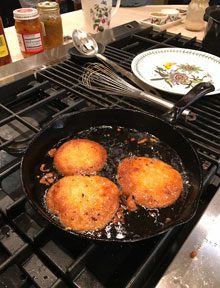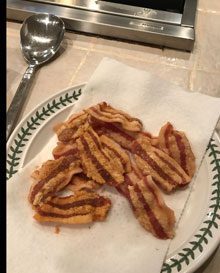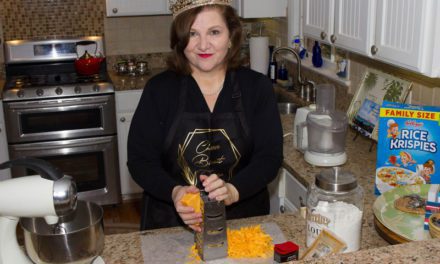 When I talk about going home or people from home, I usually mean Wilson, North Carolina. After twenty-five years of living in South Carolina, I’m learning that home folks to me are actually people from up and down the eastern stretch of North Carolina’s highway I-95. People who have a bit of vinegar and pepper in their blood.
When I talk about going home or people from home, I usually mean Wilson, North Carolina. After twenty-five years of living in South Carolina, I’m learning that home folks to me are actually people from up and down the eastern stretch of North Carolina’s highway I-95. People who have a bit of vinegar and pepper in their blood.
People who know what hoe cakes, streak o’lean and chow chow are. People who have actually tasted souse meat and liver pudding. Intelligent human beings who know that the only true barbecue is slow-roasted, whole hog pork barbecue, chopped and seasoned with vinegar and red pepper. My people. Sometimes a comforting voice with an eastern North Carolina drawl, one who talks way too fast for most people to understand, and calls Wilson, “Wiltzen;” Fayetteville, “Fedville;” and Beaufort, “Bowfert” is just plain heartwarming. I never imagined how homesick I would be for the foods from my childhood – meals that I took for granted and just assumed would always be readily available – foods that I didn’t even realize that I cared about, things like chicken and dumplings, field peas and snaps, fried cornsticks and fatback.
 In North Carolina, we boast an excellent publication called Our State Magazine. A few years ago, Our State ran an article about Collard Sandwiches that were served at a little restaurant in Lumberton, NC, about two and a half hours down I-95 from Wilson, called the Snak Shak. Collard greens are one of my all-time favorite vegetables. I was more intrigued the more I read. The article described a sandwich made with two thin round patties of fried cornbread filled with collards, fat back and chow chow or vinegar.
In North Carolina, we boast an excellent publication called Our State Magazine. A few years ago, Our State ran an article about Collard Sandwiches that were served at a little restaurant in Lumberton, NC, about two and a half hours down I-95 from Wilson, called the Snak Shak. Collard greens are one of my all-time favorite vegetables. I was more intrigued the more I read. The article described a sandwich made with two thin round patties of fried cornbread filled with collards, fat back and chow chow or vinegar.
Vince and I have a local friend who grew up in Lumberton and still has family there, Dusty Conner. Dusty also happens to be a fabulous cook and has the gift for cooking foods that remind me of my Granny Baker’s kitchen and her Sunday lunches. So, of course, I messaged Dusty immediately. “Hey Dusty! Have you ever eaten a Collard Sandwich? They’re supposed to be straight from Lumberton. Are they as yummy as they sound?” Dusty wrote back, “Yes, they are. I’ll try to bring one back.” I was beginning to feel like Pavlov’s dog. “I’ve gotta get one of these. You have to hook me up the next time you go to NC. They’ll even send it in pieces to put together at home.” Dusty replied, “You got it.” A few days later, my heart was broken when Dusty sent me the following message. “As I was leaving Lumberton, I went by the Snak Shak. Sad to say they’re no longer open. No Collard Sandwich. Sorry.” Total disappointment.
On my birthday in December, Dusty surprised me by promising that he would make Collard Sandwiches, special for me, on New Year’s Day. True to his word, he created one of the tastiest ways that I’ve ever eaten collards and cornbread together. With a glass of c hampagne in my hand, I stood at the end of his bar and watched him make a thin batter of cornmeal and water. He heated vegetable oil in a cast iron skillet over an open flame. Then, for extra flavor, he added a few big dollops of bacon grease. When it was hot enough, he added some of the batter to the oil. As the edges of the cornbread started to turn brown, he would flip them over and cook the other sides. He made batch after batch of crispy fried cornbread, three hoe cakes at a time. Collard greens had been prepared in advance, along with fried hog jowls and streak o’lean. Dusty had also set out a collection of chow chow, artichoke relish and spicy pickled vegetables to garnish the collards. Guests lined up to taste his North Carolina delicacy. When it was my turn, I placed a gracious helping of collards between two of the hoe cakes, topped the collards with a couple of pieces of streak o’lean and a spoonful of chow chow. Delicious. It was everything that I had dreamed about – and more. So there you have it. An honest-to-goodness Collard Sandwich. Thank you, Dusty!
hampagne in my hand, I stood at the end of his bar and watched him make a thin batter of cornmeal and water. He heated vegetable oil in a cast iron skillet over an open flame. Then, for extra flavor, he added a few big dollops of bacon grease. When it was hot enough, he added some of the batter to the oil. As the edges of the cornbread started to turn brown, he would flip them over and cook the other sides. He made batch after batch of crispy fried cornbread, three hoe cakes at a time. Collard greens had been prepared in advance, along with fried hog jowls and streak o’lean. Dusty had also set out a collection of chow chow, artichoke relish and spicy pickled vegetables to garnish the collards. Guests lined up to taste his North Carolina delicacy. When it was my turn, I placed a gracious helping of collards between two of the hoe cakes, topped the collards with a couple of pieces of streak o’lean and a spoonful of chow chow. Delicious. It was everything that I had dreamed about – and more. So there you have it. An honest-to-goodness Collard Sandwich. Thank you, Dusty!
Here’s the recipe. I’ve included a little food dictionary at the end. Ask your butcher for hog jowls, streak o’lean, salt pork and/or fatback. Friends tell me that locally, Piggly Wiggly is your best bet. Chow chow can be found on the condiment aisle. Happy New Year!
Collard Sandwich
1½ cups yellow self-rising cornmeal
2/3 cup water
Vegetable oil, for frying
Bacon grease (optional)
Cooked collard greens
Fried hog jowls, streak o’lean or fatback
Chow chow or hot peppers Place the cornmeal in a medium-sized mixing bowl. Stir in the water and mix to incorporate the two ingredients. If the batter is dry, add a little more water as needed for a smooth consistency. The batter should be thin. Heat oil (and bacon grease, if desired) in a cast iron skillet. Drop a spoonful of batter into the hot oil. Watch for the edges to brown, then carefully flip the cornbread over. Fry until golden brown on both sides. Remove hoe cakes from oil and drain on paper towels. Repeat until all batter is used. To assemble the Collard Sandwich, use a slotted spoon to drain off as much pot liquor as possible, and place a heaping spoonful of cooked collard greens between two hot pieces of the fried cornbread. Top collards with fatback and chow chow.
Place the cornmeal in a medium-sized mixing bowl. Stir in the water and mix to incorporate the two ingredients. If the batter is dry, add a little more water as needed for a smooth consistency. The batter should be thin. Heat oil (and bacon grease, if desired) in a cast iron skillet. Drop a spoonful of batter into the hot oil. Watch for the edges to brown, then carefully flip the cornbread over. Fry until golden brown on both sides. Remove hoe cakes from oil and drain on paper towels. Repeat until all batter is used. To assemble the Collard Sandwich, use a slotted spoon to drain off as much pot liquor as possible, and place a heaping spoonful of cooked collard greens between two hot pieces of the fried cornbread. Top collards with fatback and chow chow.
Eastern North Carolina Food Dictionary (essential knowledge for Collard Sandwich preparation)
Hoe Cake: cornbread made minimalist—a thin, unleavened round made from the simplest batter (cornmeal, water and salt), crisp at the edges, glistening on both  sides from the fat it was fried in, golden in patches. A hoe cake should be sturdy enough to work as a shovel for whatever is on the plate, but delicate enough to be appealing on its own.
sides from the fat it was fried in, golden in patches. A hoe cake should be sturdy enough to work as a shovel for whatever is on the plate, but delicate enough to be appealing on its own.
Pot Liquor (Pot Likker): is the liquid that is left behind after boiling greens (collard greens, mustard greens, turnip greens); it is sometimes seasoned with salt and pepper, smoked pork or smoked turkey.  Hog Jowls: pork jowl (alternately called jowl bacon or, especially in the Southern United States, hog jowl) is cured and smoked cheeks of pork.
Hog Jowls: pork jowl (alternately called jowl bacon or, especially in the Southern United States, hog jowl) is cured and smoked cheeks of pork.
Streak O’Lean (Streak of Lean): is the common name given to the  much leaner version of salt pork or fatback. Streak O’ Lean is kind of the opposite of bacon. Where bacon is smoked and has a streak of fat among the lean meat, Streak O’ Lean is salt cured and has a streak of lean among the fat. It is typically boiled to remove much of the salt content and then fried until it starts to develop a crisp exterior.
much leaner version of salt pork or fatback. Streak O’ Lean is kind of the opposite of bacon. Where bacon is smoked and has a streak of fat among the lean meat, Streak O’ Lean is salt cured and has a streak of lean among the fat. It is typically boiled to remove much of the salt content and then fried until it starts to develop a crisp exterior.
Salt Pork: salt-cured pork prepared from pork side, pork belly or fatback. Depending on the cut, salt pork may be lean, streaky or entirely fatty. Salt pork resembles uncut slab bacon, but is considerably saltier and not bacon-cured or smoked.
Fatback: Fatback is a cut of pork taken from a pig’s back or spinal region. Most pigs do not use their back muscles very much, so this area is made up almost entirely of dense fatty  tissue. Butchers carve the fat into blocks that can sliced and cooked as a sort of fatty bacon or fried up into crispy snacks.
tissue. Butchers carve the fat into blocks that can sliced and cooked as a sort of fatty bacon or fried up into crispy snacks.
Chow Chow: piquant pickled relish made with a combination of vegetables. No two recipes are the same. Some of the ingredients used are green tomatoes, cabbage, chayote, red tomatoes, onions, celery, hot pepper, garlic, mustard seeds, coriander, vinegar and honey. After preserving, chow chow is served cold, most often as a condiment or relish.
The writer owns Catering by Debbi Covington and is the author of two cookbooks, Gold Medal  Winner of the Benjamin Franklin Award, Celebrate Everything! and Dining Under the Carolina Moon. Debbi’s website address is www.cateringbydebbicovington.com. She may be reached at 525-0350 or by email at dbc@cateringbydebbicovington.com.
Winner of the Benjamin Franklin Award, Celebrate Everything! and Dining Under the Carolina Moon. Debbi’s website address is www.cateringbydebbicovington.com. She may be reached at 525-0350 or by email at dbc@cateringbydebbicovington.com.







